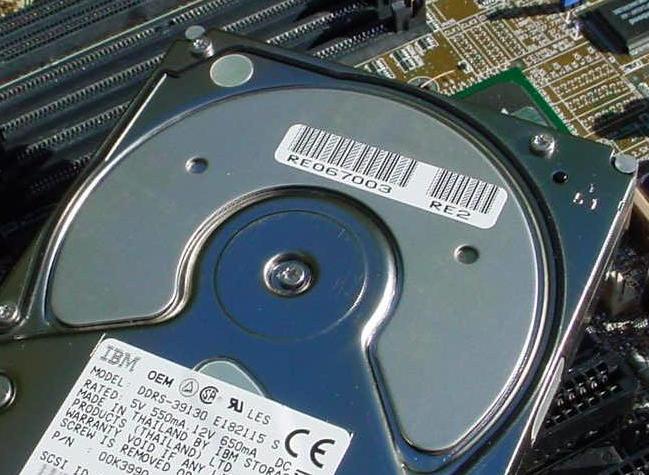
Photo: Red Hill.
IBM Ultrastar 9ES, 9LP, 18XP
IBM saw the Ultrastar 9ES as an entry-level SCSI drive to take the place of the long-running 5400 RPM Ultrastar 2 series. This in itself was quite an achievement — as the "entry-level" 9ES was easily faster than most 7200 RPM drives when it came out, and not totally shamed by 1997's 10,000 RPM racehorses, the Seagate Cheetah and IBM's own Ultrastar ZX.
Both of these drive families, the 9ES and the higher-performance 9LP/18XP, used IBM's leading-edge Extended Magneto-Resistive (MRX) head technology to squeeze more data onto each disc.
The 9LP and 18XP were faster again, though only by a small margin on paper. We have never quite worked out the point of making two drives as similar as the two 9GB models below — the LP had a bigger cache and was positioned higher in the market, but both had 7200 RPM spindles and ten heads, they were only one millisecond apart in seek time, and the data transfer rates were almost identical. Then again, sometimes we think that not even IBM ever understood IBM's marketing, so what hope did we have?
In reality, the explanation is, no doubt, that the top of the range 9LP/18XP drive was the best 7200 RPM drive that IBM could produce at the time (i.e., a "normal" model), but that the 9ES was unusual: IBM had decided, quite correctly, that the future of 5400 RPM entry-level SCSI drives was limited and jumped their Ultrastar 2 replacement up to 7200 RPM. Seagate was finishing up the long-running 5400 RPM SCSI Hawk line at about the same time for much the same reasons. The 9ES, in other words, had out-of-category performance almost by accident, and was a real bonus for drive buyers. Our Red Hill workshop server still ran a pair of 9ES drives alongside two early-model 10,000 RPM drives until about 2005 or so.
Note that we don't give a reliability rating for SCSI drives: both because we rarely see enough of any particular model to justify one, and because all 'real' SCSI drives — that is, purpose-manufactured ones, as opposed to cheap IDE drives with a SCSI interface grafted on as an afterthought — should be in the AAA+ class as a matter of course. Given the price of them, anything less is unacceptable.
| Ultrastar 9ES: | Performance | 1.31 | |
| Data rate | 171.1 Mbit/sec | Spin rate | 7200 RPM |
| Seek time | 7.5ms | Buffer | 384k |
| Platter capacity | 1.83GB | Read Channel | PRML |
| DDRS-34560 | 4.56GB | 5 MRX heads | 3½" 1/3 height |
| DDRS-39130 | 9.13GB | 10 MRX heads | 3½" 1/2 height |
| Ultrastar LP & 18XP: | Performance | 1.38 | |
| Data rate | 179.2 Mbit/sec | Spin rate | 7200 RPM |
| Seek time | 6.5 or 7.5ms | Buffer | 1MB |
| Platter capacity | 1.83GB | Read Channel | PRML |
| DGHS-39110 | 9.11GB | 10 MRX heads | 3½" 1/3 height |
| DGHS-318220 | 18.22GB | 20 MRX heads | 3½" 1/2 height |